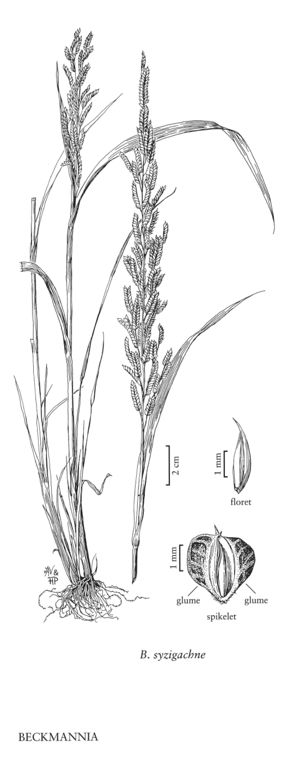| Taxon | Illustrator ⠉ | |
|---|---|---|
 | Beckmannia syzigachne | Linda Ann Vorobik Hana Pazdírková |
Plants annual and tufted, or perennial and rhizomatous. Culms 20-150 cm, sometimes tuberous at the base, erect. Leaves mostly cauline; sheaths open, glabrous, ribbed; auricles absent; ligules membranous, acute; blades flat, glabrous. Inflorescences dense, spikelike panicles; branches 1-sided, racemosely arranged, secondary branches few, at least some branches longer than 1 cm, with closely imbricate spikelets; disarticulation below the glumes, the spikelets falling entire. Spikelets laterally compressed, circular, ovate or obovate in side view, subsessile, with 1-2 florets; rachillas not prolonged beyond the base of the distal floret. Glumes subequal, slightly shorter than the lemmas, inflated, keeled, D-shaped in side view, unawned; calluses blunt, glabrous; lemmas lanceolate, inconspicuously 5-veined, unawned; paleas subequal to the lemmas; lodicules 2, free; anthers 3; ovaries glabrous. Caryopses shorter than the lemmas, concealed at maturity, x = 7.
Distribution
Wash., Wis., Wyo., N.Mex., N.Y., Pa., Calif., Nev., Colo., Alaska, Ill., Iowa, Ariz., Idaho, N.Dak., Nebr., S.Dak., Maine, Ohio, Utah, Mo., Minn., Mich., Kans., Mont., Alta., B.C., Greenland, Nfld. and Labr. (Nfld.), Man., N.B., N.S., N.W.T., Nunavut, Ont., P.E.I., Que., Sask., Yukon, Oreg.
Discussion
Beckmannia is a genus of two species: an annual species usually with one fertile floret per spikelet that is native to North America and Asia, and a perennial species with two fertile florets per spikelet that is restricted to Eurasia.
Selected References
Lower Taxa
"decumbent" is not a number.